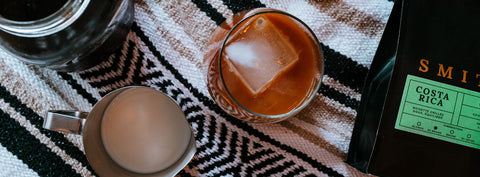Which coffee machine to choose for the home?
We have noticed it in branches, more and more of you are developing a passion for coffee, you are looking, as customers, to learn, better understand and improve your general knowledge, which is very stimulating for us! There are often questions that come up about the different methods of infusion, whether in relation to the grind, the techniques or the equipment. We take this opportunity to give you some suggestions of beans to choose from us for each type of infusion. Here is an overview of the most popular methods, excluding espresso machines which we will cover in a future article, because more and more of you are buying them for home.
French press
The French press is commonly referred to as a “Bodum” or French press. It has the advantage of being very simple and quick to use, regardless of your experience . What is good is that it is easily transported. It is therefore not surprising that we often find them in equipped chalets for rent, for example.
How it works?
The principle is simple: water and coffee infuse together in the coffee maker, just before the metal mesh filter presses the coffee to separate it from the water, sending it to the bottom, thanks to the piston. Before pushing the plunger, stir the coffee with a spoon to mix the coffee and hot water well, then let steep for about 4 minutes. Once the plunger is pushed to the bottom, wait 2 minutes before serving, so that the particles settle. The holes in the filter are relatively coarse, so they will let the oils through well and you get an interesting texture. You will need fairly coarsely ground coffee.
Bean Suggestions: Costa Rica, Ethiopia, Sumatra, Charles Smith, Island Tour, Notre Dame (decaffeinated).
Chemex or V60

Chemex or V60 are used in the same way. In both cases, it will be an infusion that is called "manual", because you have to pour the water yourself as the infusion is made and flows into your carafe in a fine continuous stream. Basically, it's like being the drip coffee maker, but with greater control over the brew settings. You can do this technique with a naked eye, but you won't have a consistent result, so using a scale is ideal.
How it works?
First, you must rinse your paper filter or your fabric filter well, then place your carafe and the V60 or the chemex on your scale to weigh empty. Then add 60g of coffee for one liter of water. The next step is to saturate the grind with a little water, to make it swell slightly for about 30 seconds, then continue to pour the water continuously, slowly and in small doses until the right volume of water is reached. It is ideal to use water that will have a temperature between 90 and 94 degrees Celsius so as not to burn your coffee and create bitterness. For a good result, go with a medium grind.
Grain suggestions: Mexico, Villalobos, Ethiopia, Costa Rica.
Aeropress

Definitely one of the most compact and practical methods, also very popular with outdoor enthusiasts. The Aeropress can brew a cup of drip coffee, but also stronger, more concentrated coffee that you can dilute with hot water. It is also a method that ideally requires the use of a balance.
How it works?
First you have to install the small round paper filter and weigh your empty Aeropress on the scale. Add 12g of coffee and weigh again on the scale. Then add 200 ml of hot water and stir gently. Let sit for about two minutes before stirring again, then press the coffee onto a stable surface, directly into your mug or a glass carafe. For the grind, you can go according to your taste, a fine grind will give a stronger taste, while a medium grind will give a lighter result.
Grain suggestions: Saint-Laurent, Mexico, Costa Rica, Montcalm.
Italian coffee maker
It is also called "mocha" or "coffee maker on the fire". This coffee maker uses steam pressure to produce strong coffee with a smooth texture .
How it works?
It is necessary to fill with cold water the tank of the lower part of the coffee maker, until arriving under the safety valve which is always easily visible. Then fill the filter with coffee without compacting it, but up to the edge. Place the filled metal filter in the reservoir and screw the upper part onto the lower part of the coffee maker. Place everything on your stovetop over medium heat. When the water boils, the coffee will start to rise in the lower part, through the central tube. Remove the coffee maker from the heat when you hear a bubbling sound and no more coffee rises to the top when lifting the lid. The ideal grind will be medium, because if too fine, you will find grains in your cup.
Bean suggestions: 1653, Montcalm, Sumatra, Saint-Laurent, Notre-Dame (decaffeinated).
Finally, you will notice that it is important to adapt the grind of your coffee beans according to the machine you use. Without this important detail, you will not have an optimal and stable experience. If you are a big consumer of coffee on a daily basis, I advise you to equip yourself with a grinder at home. If not, don't hesitate to ask us to grind your coffee upon purchase, we'll happily adapt it to your preferred brewing method!

SARAH-EVE ,
Barista expert, trainer & writer on our blog. Meet Sarah-Ève every day of the week in our Limoilou branch!
Check out his story here...
.




Comments (0)
There are no comments for this article. Be the first one to leave a message!